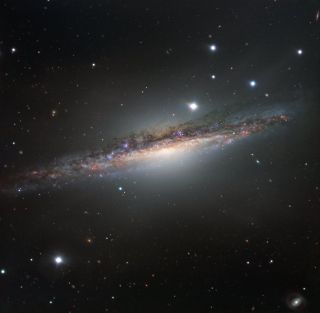Spiral Galaxy Captured in Unique, Gorgeous Edge-On View (Video, Photos)
A stunning new photo captures a unique edge-on view of a large spiral galaxy, revealing remarkable details of the galaxy's star populations and odd twists in its structure.
The spiral galaxy, named NGC 1055, is located roughly 55 million light-years from Earth in the constellation of Cetus (the Sea Monster). A recent image from the European Southern Observatory's (ESO) Very Large Telescope captures NGC 1055 from the side, showing it as a bright, colorful streak of gas, dust and countless twinkling stars.
The new observations also suggest that NGC 1055 is up to 15 percent wider than Earth's own Milky Way galaxy (whose diameter is about 100,000 light-years), according to a statement from ESO. [Stunning Photos of Our Milky Way Galaxy (Gallery)]

Generally, the dust and whirling arms of spiral galaxies such as the Milky Way look flat when seen edge-on, because they are oriented differently toward Earth. However, the new image of NGC 1055 offers a 3D view and showcases the galaxy's overall shape.
"When seen edge-on, it is possible to get an overall view of how stars — both new patches of star birth and older populations — are distributed throughout a galaxy, and the 'heights' of the relatively flat disc and the star-loaded core become easier to measure," ESO officials wrote in the statement Wednesday (March 1).

"Material stretches away from the blinding brightness of the galactic plane itself, becoming more clearly observable against the darker background of the cosmos," the officials added.
Using this edge-on perspective, astronomers found evidence of warping, as NGC 1055's disc bends and twists across the galaxy's core. This unusual structure is likely the result of an interaction with the nearby galaxy Messier 77, ESO officials said. The gravitational force behind this kind of interaction can distort the galaxies' shapes, as their stars, gas, and dust merge over millions of years, they added.
Get the Space.com Newsletter
Breaking space news, the latest updates on rocket launches, skywatching events and more!
The newly released image was captured by the FOcal Reducer and low dispersion Spectrograph 2 instrument mounted on Unit Telescope 1 of the Very Large Telescope, which is located at ESO's Paranal Observatory in Chile.
Follow Samantha Mathewson @Sam_Ashley13. Follow us @Spacedotcom, Facebook and Google+. Original article on Space.com.
Join our Space Forums to keep talking space on the latest missions, night sky and more! And if you have a news tip, correction or comment, let us know at: community@space.com.

Samantha Mathewson joined Space.com as an intern in the summer of 2016. She received a B.A. in Journalism and Environmental Science at the University of New Haven, in Connecticut. Previously, her work has been published in Nature World News. When not writing or reading about science, Samantha enjoys traveling to new places and taking photos! You can follow her on Twitter @Sam_Ashley13.
